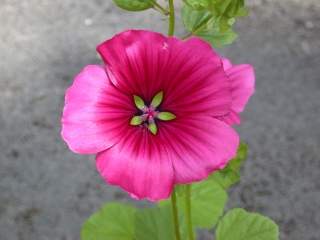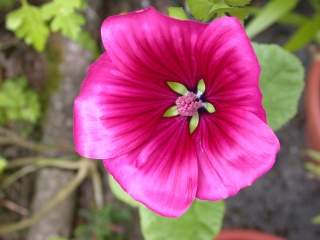 Introduction
IntroductionMalope anatolica Huber-Mor.
Malope trifida Cav.
Malope malacoides L.
Malvaceae Info (Home)
The Malope Gallery
 Introduction
Introduction
Malope L. is a genus of 3 species of annual to perennial herbs within the family Malvaceae, which also includes, inter alia, Althaea, Abutilon, Gossypium, Kitaibelia, Malva and Sidalcea. The distribution of the wild species of the genus is centred on the Mediterranean.
One of the species, Malope trifida Cav., is readily available as seed for use as an annual border plant or cut flower.
Classification
Malope was historically classified, with Kitaibelia and Palaua, in the tribe Malopeae, distinguished by the presence of a schizocarpous fruit with the mericarps arranged spirally or in several superimposed whorls. The tribe Malopeae is no longer accepted, and Kitaibelia and Malope are included in the tribe Malveae and sub-tribe Malvinae. This is confirmed by DNA sequencing. The most closely related genera to Malope and Kitaibelia are Alcea and Althaea
Technically Malope can be distinguished from Kitaibelia by the presence of 3 epicalyx segments, as opposed to the 6-9 epicalyx segments borne by Kitaibelia. In practice Kitaibelia vitifolia is also a much bigger plant than species of Malope, and the white or pale pink flower colour of Kitaibelia vitifolia constrasts with deep pink or purple flowers of the typical forms of Malope. In fruit the globose schizocarp serves to distinguish it from all remaining European mallows. The mericarps are single-seeded, indehiscent, glabrous and rugulose.
The genus was erected by Linnaeus in 1735. There are two species covered in Flora Europaea [1]: Malope malacoides L. and Malope trifida Cav. A third species is found in Turkey. Furthermore, one of the cultivated seed strains of Malope trifida, Malope 'Vulcan', is a tetraploid. Although species with variable chromosome counts are not unknown, it seems likely that even if wild-type Malope trifida crosses with Malope 'Vulcan', the progeny would be triploid and sterile, and hence the two taxa are reproductively isolated. For those persons who subscribe to the biological species concept (BSC) this would mean that Malope 'Vulcan' is a 4th species of the genus, of cultivated origin.
Flora Europaea also mentions Malope multiflora Cav., which is described of being of uncertain identity and possible not a Malope at all. INRA [2] lists this as a synonym of Lavatera cretica.
IPNI [3] lists Malope indica (this was an orthographical error 3) as a synonym of Melicope indica; Malope malacoides Walt. as a possible synomym of Malvastrum tricuspidatum; Malope parviflora L'Herit. as a synonym of Palaua parviflora Hochr.; and Malope vitifolia (Willd.) Hegi as a synonym of Kitaibelia vitifolia Willd. It also lists species lutea, rhodoleuca and rotundifolia, none of which I have been able to identify as either synonyms or valid species. Finally, Vaucher [4] refers to a Malope grandiflora from Nepal. His description is of a plant phylogenetically distant from Malope.
Cytology:
Malope trifida has 44 chromosomes.
Malope trifida Cav.
![]() Annual Malope
Annual Malope![]() Mallowwort
Mallowwort![]() Purple Spanish Mallow
Purple Spanish Mallow Sommermalve, Trichtermalve
trechtermalva
Praktmalva
Trompetkatost
Sommerstokkrose
Maloppi, Kolmihalkoinen malope
kolmehõlmane lehterlill, suureõieline lehterlill
![]() Slézovka trojklanná
Slézovka trojklanná slezovka trojzárezová
Malope trifida Cav. is a species from North West Africa, with a doubtfully native presence in south west Spain and south central Portugal. It is also naturalised, or occurs as a casual in other parts of Europe. It is also reported from Malta [5].
It is an annual, with a single, stout, erect, stem growing up to 1.5m in height. It is hairless except for the edges of stipules, bracts and sepals. The leaves are born on long petioles. They range up to 3"×4" in size, but are often much smaller. The lower leaves are suborbicular; the upper have 3-5 broad triangular lobes. Both are crenate to dentate.
The flowers are borne solitarily, on long pedicels, in the leaf axils. The epicalyx segments are orbicular-cordate, about ½" long when in flower, increasing to 1¼" when in fruit. The sepals are broadly lanceolate to ovate. The petals range in size from 20×35mm to 40×60mm. In the wild form they are a deep purplish-red, but the cultivated forms have flowers in shades of white, pink or red. There are gaps between the bases of the petals, allowing the calyx to show through, forming a 'green eye'. (This characteristic is shared by Kitaibelia vitifolia, and a number of other mallows.)
Propagation:
By seed, sown in spring, lightly covered by soil, in the flowering position. Alternatively, indoors, in late winter or early spring, at 20+°C, on the surface of a seed compost, covered by a 1 mm covering of compost or vermiculite.
Cultivars:
 Mixed colours of Malope trifida are
usually sold as grandiflora or trifida grandiflora, perhaps
qualified as "mixed" or "Choice". T&M sell a mixture of
white, pink and red under the name 'Glacier Fruits'. There are other mixtures
sold under the name 'Excelsior' and 'Frutti'.
Mixed colours of Malope trifida are
usually sold as grandiflora or trifida grandiflora, perhaps
qualified as "mixed" or "Choice". T&M sell a mixture of
white, pink and red under the name 'Glacier Fruits'. There are other mixtures
sold under the name 'Excelsior' and 'Frutti'.
There are the following named single colours
Detailed description with photo-illustrations.
Images
Synonyms:
Malope ciliata FG.Dietr., Malope grandiflora FG.Dietr. and Malope malacoides var. trifida (Cav.) Samp. are synonyms of Malope trifida.
Malope malacoides L.
![]() Hairy Mallow, Malope
Hairy Mallow, Malope Fausse Mauve
Malobe
Distribution:
Malope malacoides is found in the Mediterranean and West Asia. In Europe [1] it is found in the Spanish provinces of Cadiz, Jerez and Seville, and in southern France, Corsica, Sardinia, Italy, Sicily, Malta, Albania, Greece, Crete, Turkish Thrace, and the Western Ukraine. In Asia it is found in western Turkey [6]. In North Africa it is found in Morocco, Algeria and Tunisia.
Description:
Malope malacoides is an annual to perennial multi-stemmed herb, with, usually unbranched, hispid, stems growing from 20cm to 50cm in height. The lower leaves are between 20×12mm and 50×35mm in size, sparsely pubescent, and are oblong lanceolate to ovate, and crenate. The upper leaves are 3 lobed or similar to the lower leaves. The flowers are borne solitarily on long pedicels in the axils of the upper leaves, in early to mid-summer. The epicalyx segments are orbicular-cordate, up to ½" long when in flower. They are strongly accrescent and acuminate. They are wider and shorter than the sepals. The sepals are lanceolate and acuminate, and 10-20mm in length. The petals are 20-40 mm long, and are deep rose-pink veined with purple. The fruit is a schizocarp. It is glabrous. Its mericarps form a globular cluster.
In North Africa [5, 7, 8] the species is more variable, and forms have been given ranks varying from variety to species. It is not clear to me that any warrants a rank above form, or horticultural group. I describe them here under the latter rank.
Ecology
M. malacoides is found in waste places, thickets and olive groves. It is the food plant for the caterpillars of the Rosy Grizzled Skipper, Pyrgus onopordi.
Images
Synonyms:
Malope althaeoides Moris, Malope asterotricha Pomel, Malope hispida Boiss., Malope intermedia Pomel, Malope laevigata Pomel, Malope malacoides ssp. asterotricha (Pomel) Quézel & Santa, Malope malacoides ssp. laevigata (Pomel) Quézel & Santa, Malope malacoides ssp. stellipilis (Boiss. & Reut.) Quézel & Santa, Malope malacoides ssp. stipulacea var. hispida (Boiss. & Reut.) Murb, Malope malacoides ssp. stipulacea var. intermedia Batt., Malope malacoides ssp. stipulacea (Cav.) Maire, Malope malacoides ssp. stipulacea f. latiorifolia Pau, Malope malacoides ssp. tripartita (Boiss. & Reut.) Maire, Malope stellipilis Boiss. et Reut., Malope stipulacea Cav., Malope tripartita Boiss. et Reut and Malva pedunculata Rafin. are synonyms of Malope malacoides.
Malope anatolica was described in 1965 from plants collected from the Izmir region of western Turkey. The species has rarely been seen in the wild and is presumed to be endangered.
It is a hairy-stemned annual, growing to about 1 feet in height. The leaves are cordate, orbicular, crenate or weakly 3-5-lobed, and covered with a mixture of simple and stellate hairs. The flowers are borne singly in the leaf axils. The bracteoles are cuneate and ovate (in constrast to the cordate bracteoles of the other species). The sepals are a little above ½" long, ovate, acuminate and densely pilose. The petals are bluish-red, and a little larger to twice the length of the sepals. The mericarps are transversely ridged.
References
If you have found any errors on this page, or have any further information about the genus Malope then please contact me at webmaster@meden.demon.co.uk.
© 2002, 2003, 2004, 2008 Stewart Robert Hinsley